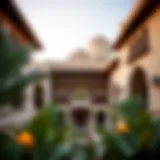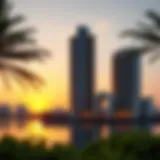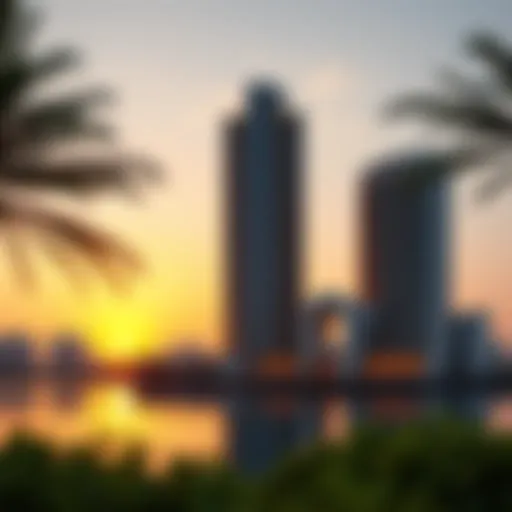Dynamic Insights into Dubai's Tower Zones
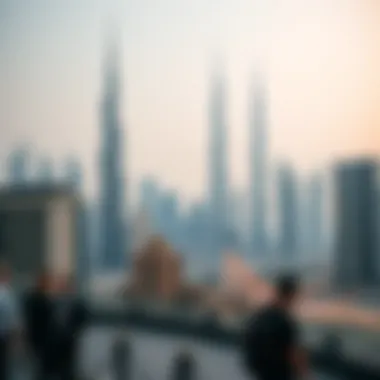

Intro
Dubai is a splendid tapestry woven with innovation, culture, and architectural brilliance. Tower zones, in particular, are the beating heart of this dynamic metropolis, each skyscraper telling a story of ambition and opulence. The blend of modernity and tradition here is unique, creating vibrant areas that not only define the skyline but also influence the social fabric and economy of the city.
These zones encapsulate diverse elements - from luxurious residential spaces that overlook sparkling waters to high-end commercial establishments that cater to a global clientele. The rise of tower zones is not merely about erecting buildings; it signifies a paradigm shift in urban living where lifestyle, investment potential, and cultural significance intersect.
As we navigate through the realms of these towering giants, we will not only uncover their architectural marvels but also delve into the trends shaping the real estate landscape. We will highlight the urban dynamics that makes these zones a hotbed for opportunities, catering to a range of stakeholders, from expatriates seeking residence to investors eyeing lucrative returns.
Market Insights
Current Trends in Dubai Real Estate
The real estate market in Dubai has seen a plethora of changes in recent times. First and foremost, there's an undeniable upsurge in demand for prime location properties. With the city’s ongoing projects and preparation for global events, the rush is palpable. Luxury housing and high-rise apartments are still in vogue, reflecting the desire for upscale living and proximity to business hubs.
Moreover, sustainability is becoming a focal point in architectural designs. Developers are now increasingly incorporating green spaces and eco-friendly innovations into their projects. People are looking for that balance between urban living and nature, aiming to contribute to their community while enjoying life in a bustling metropolis.
According to recent statistics, residential property prices have remained stable, indicating a resilient market despite global uncertainties. The rental market has seen a solid demand, driven by expatriates and young professionals eager to experience life in this vibrant city.
Emerging Areas and Investment Hotspots
While iconic areas like Downtown Dubai and Dubai Marina continue to draw crowds, emerging neighborhoods are making their mark. Dubai Creek Harbour is becoming a promising zone, showcasing modern developments with breathtaking waterfront views. Likewise, the rise of Mohammed Bin Rashid City demonstrates an intent to provide expansive green areas coupled with luxurious lifestyle amenities, appealing to families and investors alike.
Jumeirah Village Circle (JVC) and Dubai Sports City offer competitive prices without compromising on quality of life. These areas boast numerous amenities, adding value for both renters and buyers. Investors are keen on recognizing these burgeoning hotspots early, capitalizing on potential appreciation.
"Emerging areas are not just about new properties; they offer a glimpse at the future of Dubai's residential landscape."
Buyer and Renter Guidance
Comprehensive Buying Process in Dubai
Navigating through the buying process in Dubai may seem daunting, especially for first-timers. The first step is understanding the properties available. Research is essential – whether you’re seeking off-plan or ready properties, knowing the current market is pivotal.
Once a suitable property is found, potential buyers engage with a real estate agent who can help streamline the process. Next comes the negotiation stage. Effective negotiation can lead to better prices, making it crucial to approach this step with informed intentions.
Pre-approval for financing is another important step, particularly for expatriates. Mortgage options vary, and understanding different lenders will aid buyers significantly. All paperworks must be in check once an offer is made, and responsibility for transferring ownership lies on the buyer’s shoulders.
Essential Tips for Renters in Dubai
For those looking to rent, here are some crucial tips to consider:
- Know the Market: Research average rental rates in desired areas. Understanding the local rental landscape empowers tenants during negotiation.
- Use Reputable Agencies: Engage with recognized real estate agencies or agents who have a thorough understanding of local laws and communities, saving time and potential hassle.
- Inspect Properties: Always visit in person to evaluate the condition of the property and its amenities before signing anything.
- Understand Contracts: Many renters overlook details in their lease agreements. Be sure to comprehend all clauses and responsibilities outlined in the contract.
Dubai's tower zones present a myriad of opportunities. Whether you're an investor or someone looking to settle into the dynamic cultural scene, being informed is essential. With proper research and guidance, the diverse landscape of this ambitious city can offer tremendous benefits.
Understanding Tower Zones in Dubai
Dubai's skyline is a tapestry of glass, steel, and imagination, punctuated by towering sentinels that symbolize ambition and innovation. Understanding tower zones in this glittering metropolis is not merely about architecture; it’s about grasping the interplay of urban planning, real estate dynamics, and cultural narratives that define these spaces. These zones are more than just geographical markers; they represent the city’s evolution from a modest trading post to a global hub. With this context in mind, it's essential to explore the parameters that shape these tower zones, outlining not just their physical stature but their socio-economic significance.
Defining Tower Zones
Tower zones can be defined as specific areas in Dubai where vertical structures predominately shape the horizon. These zones often encompass multiple skyscrapers, each unique in design and function. Unique characteristics of tower zones include not just height and architectural style but also their purpose—such as residential, commercial, or mixed-use.
- Urban Density: Tower zones are designed to optimize space. The very concept of urban density comes into play, where vertical living becomes a necessity.
- Planning Regulations: Dubai's Urban Planning Department outlines specific guidelines that dictate how towers can be developed, influencing everything from height to aesthetic coherence.
- Economic Significance: These zones are often pivotal to Dubai's economy, contributing significantly to the real estate sector and becoming hotspots for both expatriates and investors.
Moreover, these zones are strategic as they represent areas with infrastructure ready to support their towering inhabitants—well-connected roads, public transport, and amenities are vital ingredients in the recipe for successful vertical neighborhoods.
Significance of Tower Architecture
Tower architecture in Dubai is a narrative of human ingenuity and creativity. Focusing on the significance of these structures reveals a deeper understanding of how they influence lifestyle, investment potential, and cultural identity.
- Cultural Identity: Each tower is like a story waiting to be told. From the Burj Khalifa, which speaks to the dreams of limitless heights, to the twisting facade of the Cactus Tower, these structures often reflect the culture and identity of the UAE, bridging traditional elements with modern aesthetics.
- Attracting Tourism: Iconic towers serve as landmarks, attracting millions of tourists. An example here is the Burj Al Arab, recognized the world over, which not only offers luxury but also showcases the architectural prowess of Dubai.
- Innovative Solutions: The challenges of climate and space prompt innovative architectural solutions, resulting in buildings designed with environmental sustainability in mind. Incorporating natural light, green roofs, and smart technology shows a commitment to merging luxury with sustainability.
In essence, the significance of tower architecture goes beyond mere physical structures; they capture the essence of a city that is always reaching for the stars.
"A city's architecture is a reflection of its history and its aspirations. In Dubai, towers tell stories of hope, ambition, and a future that knows no bounds."
Understanding the dynamics of tower zones in Dubai is crucial for anyone interested in the inner workings of this vibrant city. As properties within these zones continue to evolve, they embody the dreams and realities of those who live and work within their shadows.
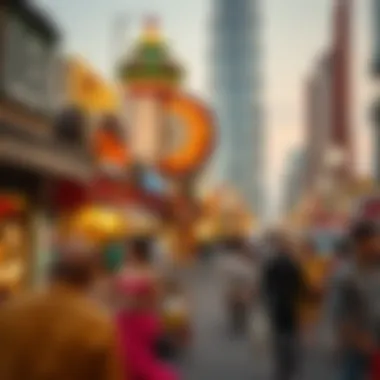
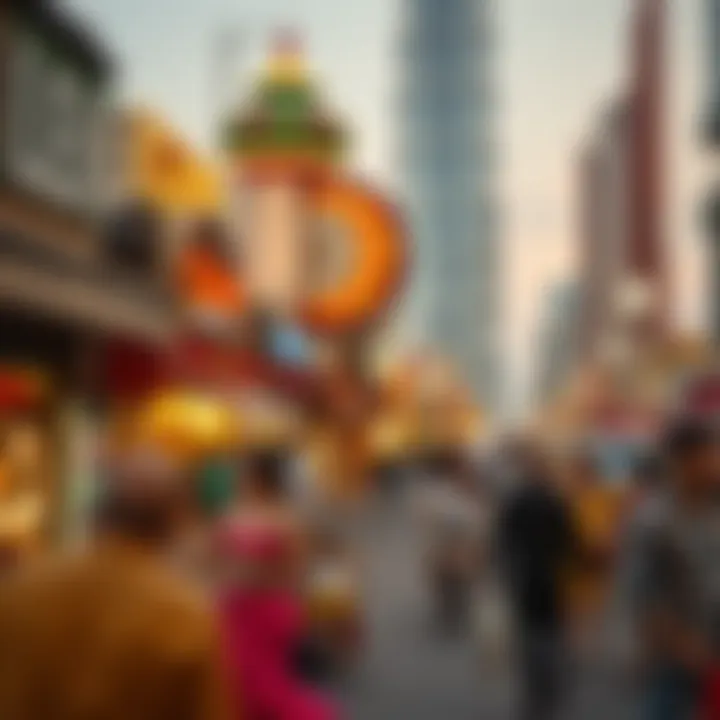
Historical Context of Tower Development
The historical context of tower development in Dubai is a vital element when examining the evolution of this vibrant city. Understanding how past decisions and milestones have influenced the current skyline provides essential insights into its architectural genius and urban identity. Over the years, Dubai has transformed from a modest coastal town into a global powerhouse of commerce and tourism, often using towers as symbols of this evolution. The context sheds light on how Dubai has navigated challenges and opportunities, the technological advancements that shaped its structures, and the socio-economic factors driving its growth. Awareness of these dynamics allows investors, expatriates, and locals to comprehend both the current climate in real estate and the overall trajectory of the city.
Evolution of Dubai's Skyline
Dubai's skyline is a narrative of progressive change, showcasing a remarkable evolution from simple structures to towering innovations that define modern architecture. Initially, the emirate's buildings were practical, reflecting traditional Middle Eastern design elements—low-rise constructions predominantly built from coral stone and gypsum.
As the oil boom in the late 20th century brought wealth into the region, the 1990s marked the beginning of an ambitious construction era. The iconic Burj Al Arab, completed in 1999, was one of the first significant departures from traditional architecture, with its sail-like structure set against the Arabian Gulf. This landmark not only redefined luxury but also set a precedent for future developments, compelling architects and investors alike to think bigger.
From the Burj Al Arab to the Burj Khalifa, which holds the title of the world’s tallest building since its completion in 2010, each tower in Dubai symbolizes a chapter in its transformation. The rapid pace of evolution has resulted in an array of architectural styles, reflecting a blend of cultural influences while illustrating UAE's ambitions on a global scale. The skyline has become an open book, telling stories of national pride, modernism, and the relentless pursuit of excellence.
Some definitional features of the evolving skyline include:
- Omni-directional Designs: Many skyscrapers feature designs that allow for stunning views from multiple angles.
- Mixed-Use Towers: A focus on creating vertical neighborhoods where residents can live, work, and socialize within the same complex.
- Sustainable Architecture: With advances in technology, green practices are increasingly influencing building design, aiming for reduced environmental footprints.
Milestones in Tower Construction
Milestones in tower construction not only mark significant achievements but also signify shifts in architectural style and urban planning strategies in Dubai. The emphasis on building taller and more ambitious skyscrapers is a reflection of the city’s aspirations and economic resilience.
Key milestones include:
- Completion of the Burj Dubai in 2009, now known as the Burj Khalifa, which redefined the boundaries of vertical construction and stands at a staggering height of 828 meters. It remains a symbol of architectural prowess and innovation.
- Dubai Marina's development in the early 2000s, wherein high-rise towers arose amid a newly created waterfront, echoing the allure of urban living that fuses residential spaces with leisure and commercial hubs.
- The introduction of the Dubai Frame in 2018 as a conceptual marker, representing a harmonious blend of history and modernity while serving as a gateway to the city’s rich heritage.
These milestones highlight not only architectural feats but also reflect broader trends in real estate, tourism, and even cultural renaissance in Dubai. As towering structures continue to rise, the city’s narrative expands, reinforcing its status as a leading destination for global investment that captivates aspiring heights not yet realized.
"Dubai's rapid tower development is not just about reaching new heights; it’s also about creating a unique space where art, culture, and technology converge to inspire a shared future."
Understanding the historical milestones gives context to what has come before and allows stakeholders to anticipate further shifts in the landscape, essential for informed decision-making in real estate and urban development.
Architectural Innovations
In the fast-paced world of real estate, innovation isn’t just a buzzword; it’s the backbone of progress, especially in a dynamic region like Dubai. Architectural innovations, particularly in tower design, have not only redefined the skyline but have also influenced the way people perceive living and working in high-rise environments. These advancements reflect a blend of aesthetics, functionality, and sustainability. Understanding architectural innovations sheds light on how Dubai continues to enhance its global standing through its vertical aspirations.
Sustainable Practices in Tower Design
Sustainable design has become a core principle in the architecture of Dubai’s towers, addressing both environmental impact and resource efficiency. The buildings are increasingly designed with energy-saving technologies and materials that minimize carbon footprints.
Benefits of Sustainable Practices Include:
- Reduced Energy Consumption: Many towers incorporate solar panels, wind turbines, or advanced insulation materials, which help lower energy bills and reduce reliance on non-renewable energy sources.
- Enhanced Indoor Air Quality: By using non-toxic materials and integrating green spaces, these designs promote healthier living and working environments, essential for the well-being of residents and tenants.
- Water Efficiency: Advanced water recycling systems and drought-resistant landscaping are becoming common, significantly decreasing water usage while maintaining aesthetic appeal.
Innovative projects like the Burj Khalifa not only set aesthetic standards but also incorporate sustainable technologies, from its rainwater harvesting systems to the energy-efficient central air conditioning system. Such strategies emphasize that luxury and sustainability can coexist symbiotically in high-rise architecture.
Iconic Structures and Their Influence
When discussing architectural innovations in Dubai, one cannot overlook the impact of its iconic structures. Buildings like the Burj Al Arab and the Cactus Tower are more than just visually captivating; they serve as embodiments of modern engineering and design philosophy.
"Architecture should speak of its time and place, but yearn for timelessness." – Frank Gehry
These structures not only attract tourists and expatriates but also redefine standards in the real estate market:
- Attraction and Marketability: High-profile towers draw attention and elevate property values in their surrounding areas, creating unique opportunities for investors and developers alike.
- Cultural Symbols: Towers such as the Burj Khalifa and the upcoming Dubai Creek Tower are seen as symbols of ambition, innovation, and the blending of tradition with modernity, greatly influencing the region's cultural identity.
- Catalysts for Urban Development: Iconic buildings often spur surrounding infrastructure development, such as transportation links and public amenities, further enhancing the locality's appeal.
Economic Factors Influencing Tower Zones
Understanding the economic landscape of tower zones in Dubai is crucial for anyone involved in real estate. These zones are not merely high-rise buildings but are intricate ecosystems influenced by various economic factors. The interplay between demand, investment, and market dynamics significantly shapes the tower landscape. A thorough grasp of these economic elements sheds light on why specific regions thrive while others stagnate.
Market Trends in Real Estate
The real estate market in Dubai exhibits a unique set of trends that can be both vibrant and volatile. When it comes to tower zones, several factors come into play:
- Price Elasticity: Knowing how sensitive property prices are to changes in demand can be pivotal. For example, luxury towers in areas like Downtown Dubai often see a higher price elasticity compared to mid-range properties.
- Supply and Demand: The balance between supply and demand dictates market prices. With an influx of expatriates and investors, demand for tower living has surged, leading to escalating rental prices in several zones. Towers near key amenities, like educational institutions and shopping malls, consistently attract higher demand.
- Investment Opportunities: Potential buyers and investors are constantly scouting for the best returns. High-visibility developments, often coupled with attractive financing options, can stimulate interest. Investors should consider factors like upcoming infrastructure projects, which can greatly impact property values.
- Rising Expat Population: As Dubai continues to attract talent from around the globe, the demand for housing in tower zones increases. This demand boosts rental yields and property sales, making these areas attractive for investors.
Understanding these elements helps you as a buyer or investor to position yourself strategically in the market. For those scouting for opportunities, knowing when to jump into the fray can mean the difference between striking gold and merely fielding a dud.
Impact of Global Economic Conditions
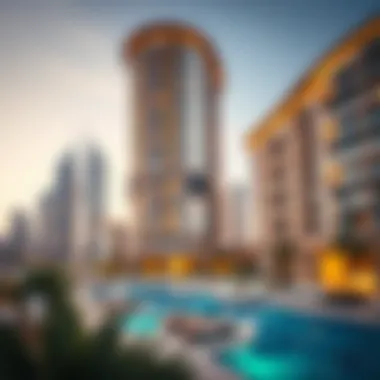
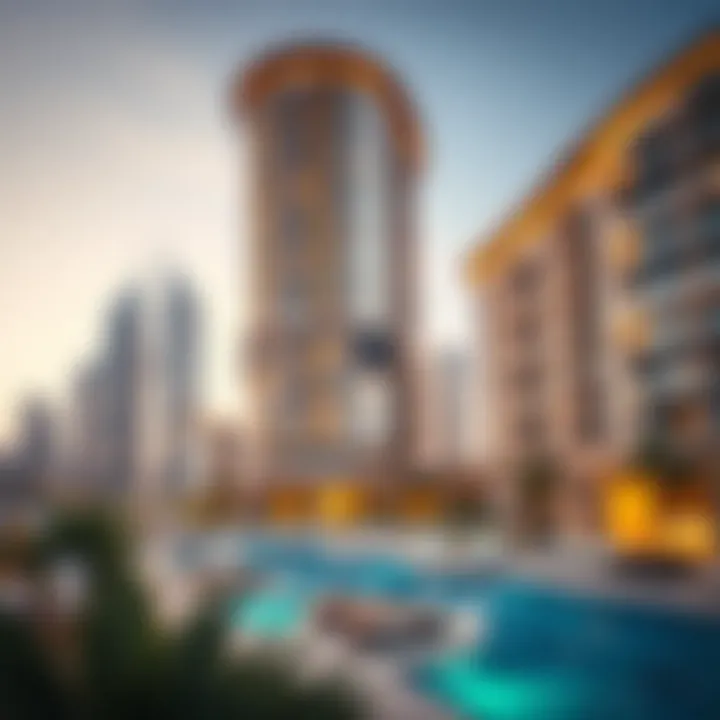
Global economic conditions hold considerable sway over the local real estate market in Dubai, particularly concerning tower zones. The influence can be broad, reaching from investor confidence to currency fluctuations. Below are some aspects worth your attention:
- Economic Cycles: Economic upturns often translate to increased investments in property, while downturns can lead to a cautious approach from investors. For instance, during periods of global recession, luxury tower sales may plummet, reflecting broader economic anxieties.
- Currency Exchange Rates: The value of the UAE Dirham against other currencies can affect foreign investments. A strong Dirham can deter overseas investors, while a weaker one can attract them in droves. It’s essential to keep an eye on these shifts to gauge market sentiments.
- Geopolitical Climate: Political stability in the Middle East can also determine the flow of investment into Dubai. A stable political environment usually correlates with increased foreign direct investment, benefitting tower zones. Conversely, instability can lead to uncertainty, causing investors to hesitate.
- Global Investor Sentiments: Investors' perspectives on Dubai’s economy internationally can influence decisions. Positive media coverage and increasing rankings in global city indexes can boost confidence and encourage purchases in tower zones.
"Understanding the global landscape helps you navigate potential pitfalls and capitalize on opportunities within Dubai's tower zones."
Awareness of these factors allows you to make informed decisions that maximize investment potential and minimize risks. The economic narratives surrounding tower zones are constantly evolving, demanding that you stay ahead of trends to ensure your investments yield fruitful returns.
Investment Potential in Tower Zones
The dynamic nature of Dubai's tower zones creates a fascinating landscape for potential investments. Dubai has positioned itself as a global hub, and these tower zones reflect its ambition and growth. Investors, both local and international, are drawn to these areas for numerous reasons. The unique architecture, coupled with the cultural vibrancy of the city, creates avenues for lucrative investments.
Evaluating Property Opportunities
When considering the property opportunities in Dubai's tower zones, several key factors come into play.
- Location: Proximity to business centers, entertainment options, and transport links can significantly influence property value. Investors should evaluate areas like Dubai Marina or Downtown Dubai, known for their stunning buildings and high demand.
- Market Dynamics: Understanding the property market trends is essential. Recent reports show a steady growth in property prices as more people flock to the emirate. Keeping an eye on demographic shifts can also give insights into upcoming hot spots.
- Rental Yields: The potential for rental income is another critical consideration. Upper-range properties in prime locations often yield higher returns, which can be enticing for investors looking to capitalize on the holiday rental market or expatriate housing needs. For instance, luxury apartments often attract affluent tenants, thus ensuring consistent income.
As one real estate expert pointed out, "Investing in Dubai's tower zones is like betting on a winning horse; it’s not just about today, but the potential it holds for tomorrow."
Risk Assessment for Investors
Investing in real estate always comes with its share of risks, and Dubai's tower zones are no different. Identifying these risks is crucial for safeguarding investments. Here are some elements investors should consider:
- Market Volatility: The property market can be cyclical, and prices may fluctuate based on global economic conditions. A thorough understanding of past market trends may help in predicting future movements.
- Regulatory Changes: Local regulations can shift, impacting ownership rights, rental laws, and tax implications. A close relationship with local real estate agents or legal advisors can provide insights into these changes.
- Construction Quality: Not all towers in Dubai maintain the highest standards. Before investing, conduct due diligence on developers, their track record, and the quality of past projects. A building that finishes late or is poorly constructed can lead to financial setbacks.
In essence, while the allure of investing in tower zones is strong, it requires careful planning and a discerning eye. Having a clear strategy paired with thorough research will prove essential in navigating this complex market.
Regulatory Environment in Dubai
The regulatory environment surrounding Dubai’s tower zones is crucial in shaping the intricate balance between innovation, safety, and real estate dynamics. Understanding the laws and regulations that govern these areas is essential for real estate investors, expatriates, homebuyers, and landlords alike. This section serves as a guide, highlighting the importance of such regulations and the benefits they can bring to various stakeholders.
Government Policies on Real Estate
Government policies play a key role in determining the landscape of real estate development in Dubai. The authorities in charge establish rules to streamline investment processes, enhance safety standards, and promote sustainable practices. Some of the most significant policies affecting tower zones include:
- Property Ownership Laws: Here, expatriates can own property in designated zones. This law has sparked considerable interest among foreign investors. It's a boon for many, but also comes with conditions that potential buyers should fully grasp.
- Building Codes and Safety Regulations: These ensure structures are safe, complying with international standards. They mitigate risks of disasters and contribute to the towers' long-lasting integrity.
- Zoning Laws: Specific areas are designated for commercial, residential, or mixed-use developments, guiding investors towards types of projects that are viable.
A clear understanding of these policies can help stakeholders capitalize on opportunities while adhering to necessary legal requirements. Investors should keep their due diligence sharp; failing to understand local regulations may lead to costly repercussions.
Legal Considerations for Buyers
For buyers looking to invest in Dubai's thriving tower zones, there are several legal considerations they must navigate. Knowing the particulars can make all the difference between a successful venture or a regrettable one.
- Verification of Title Deeds: Before making a purchase, verifying the legitimacy of title deeds is critical. This step ensures that the seller has the right to sell the property, preventing possible disputes in the future.
- Understanding Service Charges: Buyers should be aware of the service charges associated with high-rise living. These can include maintenance fees, which are vital for the upkeep of shared facilities in tower living.
- Tenancy Laws: Should the property be intended for rental, familiarity with tenancy laws in Dubai is essential. These laws define the rights and responsibilities of landlords and tenants, influencing potential investment returns.
- Financing Options: Different financing options are available, but buyers should understand the requirements and implications of each. For instance, securing a mortgage might require specific documentation and adherence to local banking rules.
"Navigating the legal labyrinth of Dubai's real estate can be daunting; however, it's imperative for safeguarding one's investments and ensuring peace of mind."
In summary, grasping the regulatory environment surrounding Dubai’s tower zones not only informs buyers of the opportunities and responsibilities they face but also guides them toward making wise and informed investment decisions. By paying heed to these regulations, investors can engage with confidence in what is undeniably a vibrant and ever-evolving market.
Cultural Implications of Tower Living
The tower zones in Dubai are more than just concrete giants scraping the sky; they are beacons of modern culture and social evolution. With their soaring heights and stunning facades, these structures have transformed not just the skyline, but also the way people experience life in the city. The focus on cultural implications is paramount in understanding how these living spaces shape and reflect the values, norms, and aspirations of those who inhabit them.
The significance of tower living extends into the daily lives of residents, influencing their lifestyle choices and community interactions. When individuals choose to reside in high-rises, they are engaging in a specific cultural narrative that melds convenience, luxury, and a sense of belonging. This decision is often fueled by various factors, one of which is the allure of a vibrant urban lifestyle that towers facilitate. Living in high-density environments allows for immediate access to a myriad of amenities—from cafes with panoramic views to cultural landmarks that welcome exploration and engagement.
Beyond personal conveniences, towers also serve as a microcosm of society. They bring together diverse populations, fostering a melting pot of cultures, languages, and ideas. As residents share the same staircases and amenities, it creates opportunities for organic interactions. This heightens the sense of community, where people come from different backgrounds yet can connect on common ground. Moreover, the towers often dictate social gatherings and events, enhancing shared experiences that fortify community ties.
This diverse blend presents both benefits and challenges. On the one hand, the increased interactions heighten cultural exchange and understanding; people rapidly adapt to various lifestyles and customs. On the other hand, cultural dissonance can arise too, as varying norms sometimes clash, leading to friction among residents. Navigating this landscape requires a certain level of emotional intelligence and adaptability.
"In a city as dynamic as Dubai, the way we live reflects a constant negotiation between tradition and modernity. Tower living embodies this dance perfectly."
One can’t ignore that the preference for tower residences is also a reflection of global trends in urbanization. As cities worldwide combat common challenges like population density and resource scarcity, the model of high-rise living offers a solution that is both practical and aspirational. For expatriates and locals alike, the prospect of waking up in a tower with breathtaking views or communal spaces that encourage interaction feels like not just a home, but a lifestyle statement.
Lifestyle Choices Influenced by Tower Culture
When examining how tower living influences lifestyle choices, several elements come into play. The environment within these high-rises encourages residents to adapt their daily routines, promoting an active lifestyle enriched with activities.
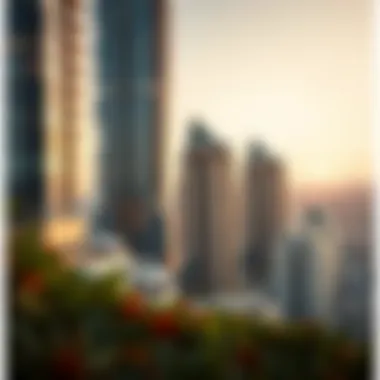
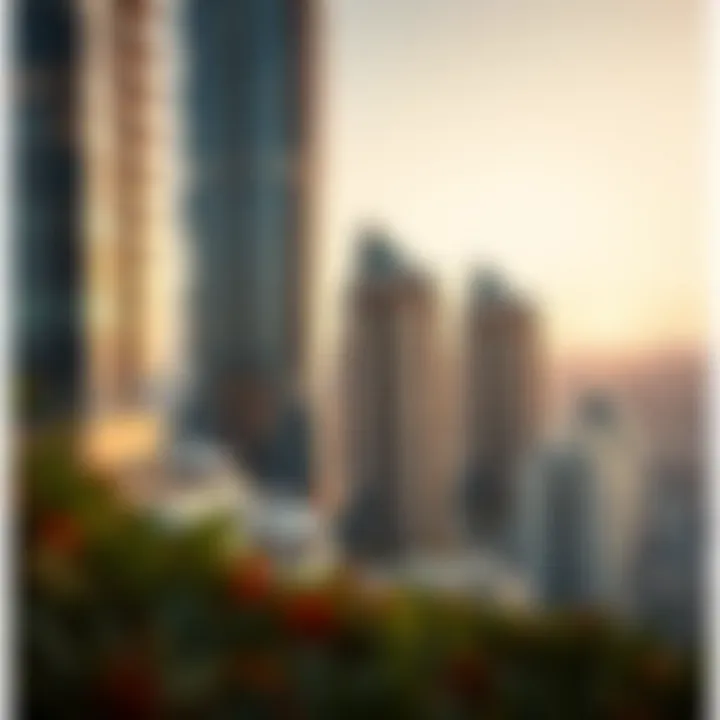
One notable aspect is the proximity to leisure and entertainment options—many towers come equipped with gyms, rooftop pools, and communal lounges. Residents find themselves less dependent on private transport, as essential amenities are often right at their fingertips, promoting a more pedestrian-friendly approach to daily life. This shift leads to a more active community, where short walks to coffee shops or nearby parks become the norm.
Additionally, an array of dining establishments and cultural venues within these districts compels individuals to indulge in culinary adventures and artistic experiences regularly. This fosters a culture of exploration, pushing residents to step outside and engage with the diverse offerings of their environment.
Community Trends in High-Rise Living
The way residents interact within tower communities contributes significantly to social trends. For example, many high-rises are moving towards fostering shared spaces that encourage interaction among neighbors. Features like recreation rooms or shared gardens cultivate social bonds, prompting a sense of belonging.
Moreover, it’s common to find organized events like movie nights or holiday celebrations within these towers, further affirming community spirit. These initiatives reflect the growing trend of co-living, where the idea of isolation fades in favor of camaraderie and shared experiences.
Lastly, as these buildings often house a diverse range of residents, the multiplicity of cultures leads to enriched social dynamics. People learn from one another, sharing customs and traditions, creating a vibrant mosaic of life within the tower. This is particularly appealing to families who may wish to expose their children to various cultures from an early age, enriching their worldview.
In summary, it is clear that tower living in Dubai presents unique lifestyle choices and community dynamics that significantly contribute to the residents' experiences. The towers are not merely architectural feats; they are integral to shaping a new societal landscape.
Challenges Facing Tower Developments
Tower developments in Dubai are often seen as symbols of luxury and progress. Nonetheless, they are not without their challenges. Recognizing and addressing these issues is crucial for sustainable growth in the city’s property sector, which is vital for real estate investors, expatriates, homebuyers, agents, and landlords. Understanding these challenges can lead to better decision-making and ultimately, more successful investments.
Urban Planning and Infrastructure Issues
In the rapid growth of Dubai, urban planning plays a fundamental role. The city’s ambitious expansions have sometimes been likened to putting the cart before the horse. Developers often find themselves in a race against time to erect skyscrapers without adequate infrastructure in place. This can lead to several complications:
- Traffic congestion: High-density towers bring more residents and businesses, which can overload existing road networks and public transportation systems. If the necessary infrastructure isn't developed in tandem with new buildings, the daily commute could become a headache for residents.
- Utilities strain: Water, electricity, and sewage systems must keep pace with tower development. Strain on these utilities can lead to outages and interruptions, damaging residents’ quality of life.
- Green spaces and community planning: As skyscrapers rise, the city risks neglecting public amenities. Areas for parks, schools, and recreational facilities are essential for vibrant communities, yet these can often be an afterthought in urban planning.
If urban strategies do not keep in line with tower growth, it could jeopardize the success of both the buildings and the city itself.
Environmental Concerns Associated with Towers
Environmental factors are becoming increasingly scrutinized in the context of tower developments. Skyscrapers, while awe-inspiring, can have significant ecological impacts. A few key concerns include:
- Resource consumption: High-rises demand a lot of resources, from materials during construction to energy for heating and cooling their vast spaces. If developers do not prioritize sustainable practices, the environmental footprint can be enormous.
- Heat island effect: Towers can exacerbate local temperatures, creating heat islands that make urban areas warmer than their rural surroundings. This phenomenon can lead to increased energy consumption for cooling, causing higher utility costs for residents and greater strain on the grid.
- Biodiversity loss: The construction of new towers often encroaches on habitats. This development can negatively impact wildlife and plant species, leading to a loss of biodiversity in the area. A lack of integrated green building practices could compound these detrimental effects.
The discussion around these environmental challenges is crucial as Dubai moves towards sustainability goals. Failure to consider these implications might lead to greater backlash from residents and investors alike, who are increasingly environmentally conscious.
Investment Insight: Recognizing and addressing these challenges not only enhances the quality of life for residents but can also solidify a tower’s standing in the market. Investors should keep these concerns on their radar to make informed decisions.
In summary, the obstacles facing tower developments in Dubai demand careful consideration and strategic planning. Investors and stakeholders who are well aware of these issues can play a pivotal role in steering the city towards a more sustainable and prosperous future.
Future Trends in Tower Zones
As the iconic skyline of Dubai continues to evolve, the future of its tower zones remains a focal point for investors, architects, and residents alike. Understanding these trends is crucial for anyone looking to navigate the ever-shifting landscape of Dubai's real estate market. Innovative designs and shifting socio-economic factors pave the way for new developments. Being aware of these future trends helps stakeholders make informed decisions and maximize potential opportunities.
The Rise of Smart Towers
In recent years, the concept of smart towers has gained significant traction. These structures utilize advanced technology to optimize energy efficiency, enhance security, and improve overall living conditions. Smart towers often feature automated systems for lighting, climate control, and even waste management, making them a prime choice for modern living. With an increasing emphasis on sustainability, many developers are focusing on integrating renewable energy sources, like solar panels and wind turbines, into their designs.
The appeal of smart towers extends beyond functionality. They also provide added convenience and a unique lifestyle experience, which are attractive selling points for potential buyers and tenants. For instance, smart technologies can allow residents to control their environment via smartphones or tablets, making life in these high-rises both comfortable and efficient. This trend is not just a fad; it denotes a shift toward more connected urban spaces that prioritize residents' needs while also being mindful of environmental impact.
Integration of Technology in Real Estate
The integration of technology into real estate is reshaping how property is bought, sold, and managed in Dubai. Real estate platforms now rely heavily on data analytics to assess market trends, forecast prices, and gauge buyer preferences. Furthermore, virtual reality and augmented reality tools are becoming commonplace, allowing potential buyers to tour properties remotely, thus saving both time and resources.
Adopting these technological advancements isn’t limited to new builds. Existing tower developments are increasingly retrofitting their systems with smart technology. Upgrades like centralized heating controls or smart locks enhance security and convenience, appealing to both expatriates and locals alike.
The importance of staying ahead of these trends can't be overstated. Understanding how technology can be harnessed serves not only to enhance property value but also ensures sustainability and longevity in a rapidly changing market.
"The future of tower zones in Dubai is shaped by an ever-growing integration of technology, ensuring that these structures not only meet the demands of today but are also prepared for the challenges of tomorrow."
Ending
The exploration of tower zones in Dubai uncovers a rich tapestry of architectural splendor, cultural significance, and economic opportunity. These towering structures are more than just fleeting glimpses against the skyline; they represent the pulse of a city constantly in motion. Their importance lies not only in their visual prominence but also their multifaceted roles in real estate and lifestyle choices. Investing in these zones offers a blend of luxury living and robust investment potential, making them enticing to both expatriates and local buyers alike.
Recap of Key Insights
- Architectural Influence: Dubai’s towers reflect global architectural trends while adhering to local aesthetics, showcasing a fusion of tradition and modernity. Iconic landmarks such as the Burj Khalifa and the twisting Cactus Tower redefine what’s possible in tower design.
- Cultural Dynamics: The lifestyle shaped by tower living differs significantly from other residential environments in the city. Community-driven amenities are vital for attracting a diverse population, ensuring that residents feel a sense of belonging within the high-rises.
- Economic Landscape: The real estate market in these zones is influenced by various economic conditions, including global trends. Understanding these influences helps investors make informed decisions, capitalizing on timing and market fluctuations.
- Future Prospects: Future developments in tower architecture lean towards sustainability and technology integration, facilitating smart living. This evolution not only enhances the living experience but also ensures long-term viability in a competitive market.
Looking Ahead to the Future of Tower Zones
In the coming years, tower zones in Dubai are poised to evolve further, integrating smart technologies and innovative sustainable practices. This transition towards smart towers will incorporate advancements like energy-efficient systems and digital conveniences, attracting a tech-savvy demographic. The rise of such towers signifies a shift not just in construction methods but in the very fabric of urban living.
- Smart Towers: The concept of smart towers promises to revolutionize the way residents interact with their living spaces. Features might include app-controlled temperature settings, automated lighting, and improved security systems. These enhancements cater to a lifestyle that values efficiency and connectivity.
- Sustainability Initiatives: Building practices are increasingly leaning towards eco-friendly solutions, aligning with global sustainability goals. Green roofs, water conservation systems, and local materials in construction are becoming the norm in new developments. This not only enriches the urban environment but also diminishes the ecological footprint of high-rise living.
- Investment Strategies: As these trends unfold, savvy investors should look for properties that not only promise high returns but also maintain technological relevance in the long term. The intersection of technology and real estate paves the way for strategic investments in a rapidly changing landscape.
The journey through the dynamic aspects of Dubai’s tower zones reflects a broader narrative of urban evolution. Stakeholders—be it investors, homeowners, or architects—must remain attuned to these shifts in order to navigate the complexities of this vibrant market.
The future isn't just about reaching new heights; it's about making those heights functional, sustainable, and inclusive for all who dwell within them.






